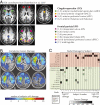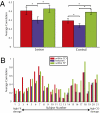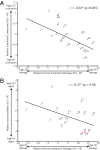Double dissociation of two cognitive control networks in patients with focal brain lesions - PubMed (original) (raw)
Double dissociation of two cognitive control networks in patients with focal brain lesions
Emi M Nomura et al. Proc Natl Acad Sci U S A. 2010.
Abstract
Neuroimaging studies of cognitive control have identified two distinct networks with dissociable resting state connectivity patterns. This study, in patients with heterogeneous damage to these networks, demonstrates network independence through a double dissociation of lesion location on two different measures of network integrity: functional correlations among network nodes and within-node graph theory network properties. The degree of network damage correlates with a decrease in functional connectivity within that network while sparing the nonlesioned network. Graph theory properties of intact nodes within the damaged network show evidence of dysfunction compared with the undamaged network. The effect of anatomical damage thus extends beyond the lesioned area, but remains within the bounds of the existing network connections. Together this evidence suggests that networks defined by their role in cognitive control processes exhibit independence in resting data.
Conflict of interest statement
The authors declare no conflict of interest.
Figures
Fig. 1.
(A) FP and CO ROI locations from Dosenbach et al. (3) (B) Degree of lesion overlap across all patients. (C) Amount of damage sustained at each node by each subject. Subjects 5–8, despite having lesions elsewhere, sustained no damage to either network.
Fig. 2.
Lesion masks in normalized space for all 21 subjects.
Fig. 3.
(A) Average FP and CO connectivity across subjects in lesion and control groups. (B) Average FP and CO network connectivity within each lesion patient sorted from high FP to high CO damage.
Fig. 4.
(A) Relative functional connectivity of CO and FP networks versus relative CO and FP anatomical damage. (B) Relative small-worldness (sigma) of CO and FP network nodes versus relative CO and FP anatomical damage.
Fig. 5.
Mean correlation values within the CO or FP networks in either patients with relatively more CO network damage or patients with relatively more FP network damage. *Significant differences between within-FP and within-CO network correlations (P < 0.05).
Similar articles
- A novel approach to clinical-radiological correlations: Anatomo-Clinical Overlapping Maps (AnaCOM): method and validation.
Kinkingnéhun S, Volle E, Pélégrini-Issac M, Golmard JL, Lehéricy S, du Boisguéheneuc F, Zhang-Nunes S, Sosson D, Duffau H, Samson Y, Levy R, Dubois B. Kinkingnéhun S, et al. Neuroimage. 2007 Oct 1;37(4):1237-49. doi: 10.1016/j.neuroimage.2007.06.027. Epub 2007 Jul 12. Neuroimage. 2007. PMID: 17702605 - Network measures predict neuropsychological outcome after brain injury.
Warren DE, Power JD, Bruss J, Denburg NL, Waldron EJ, Sun H, Petersen SE, Tranel D. Warren DE, et al. Proc Natl Acad Sci U S A. 2014 Sep 30;111(39):14247-52. doi: 10.1073/pnas.1322173111. Epub 2014 Sep 15. Proc Natl Acad Sci U S A. 2014. PMID: 25225403 Free PMC article. - Hubs of brain functional networks are radically reorganized in comatose patients.
Achard S, Delon-Martin C, Vértes PE, Renard F, Schenck M, Schneider F, Heinrich C, Kremer S, Bullmore ET. Achard S, et al. Proc Natl Acad Sci U S A. 2012 Dec 11;109(50):20608-13. doi: 10.1073/pnas.1208933109. Epub 2012 Nov 26. Proc Natl Acad Sci U S A. 2012. PMID: 23185007 Free PMC article. - Brain imaging of attentional networks in normal and pathological states.
Fernandez-Duque D, Posner MI. Fernandez-Duque D, et al. J Clin Exp Neuropsychol. 2001 Feb;23(1):74-93. doi: 10.1076/jcen.23.1.74.1217. J Clin Exp Neuropsychol. 2001. PMID: 11320446 Review. - Brain networks under attack: robustness properties and the impact of lesions.
Aerts H, Fias W, Caeyenberghs K, Marinazzo D. Aerts H, et al. Brain. 2016 Dec;139(Pt 12):3063-3083. doi: 10.1093/brain/aww194. Epub 2016 Aug 6. Brain. 2016. PMID: 27497487 Review.
Cited by
- Graph Analysis of the Visual Cortical Network during Naturalistic Movie Viewing Reveals Increased Integration and Decreased Segregation Following Mild TBI.
Ruiz T, Brown S, Farivar R. Ruiz T, et al. Vision (Basel). 2024 May 10;8(2):33. doi: 10.3390/vision8020033. Vision (Basel). 2024. PMID: 38804354 Free PMC article. - Real World Financial Mismanagement in Alzheimer's Disease, Frontotemporal Dementia, and Primary Progressive Aphasia.
Ngo S, Jackson AJ, Manivannan M, Young JC, Leggins B, Cryns NG, Tran ST, Grant HE, Knudtson MV, Chiong W. Ngo S, et al. J Alzheimers Dis. 2024;99(1):251-262. doi: 10.3233/JAD-231021. J Alzheimers Dis. 2024. PMID: 38669528 Free PMC article. - Disrupted topological organization of functional brain networks in traumatic axonal injury.
Li J, Shu Y, Chen L, Wang B, Chen L, Zhan J, Kuang H, Xia G, Zhou F, Gong H, Zeng X. Li J, et al. Brain Imaging Behav. 2024 Apr;18(2):279-291. doi: 10.1007/s11682-023-00832-z. Epub 2023 Dec 4. Brain Imaging Behav. 2024. PMID: 38044412 Free PMC article. - Neural Mechanisms Underlying the Dynamic Updating of Native Language.
Sharer K, Thothathiri M. Sharer K, et al. Neurobiol Lang (Camb). 2020 Nov 1;1(4):492-522. doi: 10.1162/nol_a_00023. eCollection 2020. Neurobiol Lang (Camb). 2020. PMID: 37215586 Free PMC article. - White matter disconnection of left multiple demand network is associated with post-lesion deficits in cognitive control.
Jiang J, Bruss J, Lee WT, Tranel D, Boes AD. Jiang J, et al. Nat Commun. 2023 Mar 29;14(1):1740. doi: 10.1038/s41467-023-37330-1. Nat Commun. 2023. PMID: 36990985 Free PMC article.
References
- Koechlin E, Ody C, Kouneiher F. The architecture of cognitive control in the human prefrontal cortex. Science. 2003;302:1181–1185. - PubMed
- Badre D, D'Esposito M. Functional magnetic resonance imaging evidence for a hierarchical organization of the prefrontal cortex. J Cogn Neurosci. 2007;19:2082–2099. - PubMed
Publication types
MeSH terms
Grants and funding
- F32 EY019618-01/EY/NEI NIH HHS/United States
- P01 NS040813/NS/NINDS NIH HHS/United States
- F32 EY019618/EY/NEI NIH HHS/United States
- MH63901/MH/NIMH NIH HHS/United States
- R01 MH063901/MH/NIMH NIH HHS/United States
- NS40813/NS/NINDS NIH HHS/United States
LinkOut - more resources
Full Text Sources
Medical




